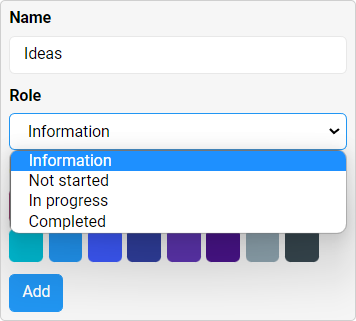-
Learn the Basics
-
- Creating Cards
- Changing Card Statuses
- Following Cards
- Scheduling Cards
- Renaming Cards
- Duplicating Cards
- Quick Actions
- Mass Actions
- Copy & Paste
- Creating Card Statuses
- Changing the Default Card Status
- Changing the Order of Card Statuses
- Deleting Card Statuses
- Moving Cards between Spaces
- Archiving Cards
- Unarchiving Cards
- Deleting Cards
- Creating Card Blockers
- Managing Card Blockers
- Adding Cards to MySpace
- Hinzufügen von Karten zu "MySpace"
- Removing Cards from MySpace
- Entfernen von Karten aus "MySpace"
- Adding Mirror Cards
- Removing Mirror Cards
-
- Documents in KanBo
- Card Documents
- Uploading or Creating Documents in Cards
- Attaching and Detaching Documents in Cards
- Space Documents
- Document References
- Document Sources
- Downloading Documents
- Editing Documents
- Editing Documents in Browser
- Editing Documents in Office Applications
- Renaming Documents
- Deleting Documents
-
Visualize Work
-
- Space Views
- Creating Space Views
- Personal and Shared Space Views
- Card Grouping
- Filtering Cards
- Display Settings
- Work Progress Calculation
- Grouping Description
- Card Grouping Settings
- Changing the Order of Groupings
- Changing the Order of Space Views
- Deleting Space Views
- Following Card Statuses and Custom Fields
-
-
Collaborate
-
Level Up Your Work
-
Work Securely
-
Integrations
-
- Advanced KanBo Actions in Power Automate
- Creating KanBo Space Attached to Subfolder Created by Power Automate
- Creating Document Folders in Document Libraries Created by KanBo with Power Automate
- Exporting Space Views to Excel
- KanBo and Azure Logic Apps Integration
- Power Automate Integration: Triggers and Actions
- Seamless Import from Microsoft Planner to KanBo
- Synchronizing KanBo with Outlook Calendar
- Using KanBo Outlook App
-
Card Status Roles
This post is also available in: Deutsch
Card statuses are to help you with the categorization of your work. It tells what stage your tasks are.
There are 4 available card status roles to choose from. Each of them has a different icon and meaning:
 Not started – The initial status by default. It points to tasks that are not currently performed.
Not started – The initial status by default. It points to tasks that are not currently performed. In progress – This status serves to indicate that a card is already in progress of completing it.
In progress – This status serves to indicate that a card is already in progress of completing it. Completed – This is a status indicating completion of the card.
Completed – This is a status indicating completion of the card.  Information – A place to locate cards that contain important information but are not executable.
Information – A place to locate cards that contain important information but are not executable.
The role of the card statuses is to show the progress of every card realization. The progress line can consist of as many steps as needed to finally complete the task.

As you can see, a role for status may appear many times or not at all. You can select multiple statuses to share the same role. In this example, you can see that there is: one status with the role Not started, 4 statuses with the role In progress, and one status with the role Completed. There is also one Informational status.

There are some special cases regarding the status of the Information role. This status can be used for cards that have an informational role. Since it does not represent the progress of completing a card, this status is not visualized in the progress line.

Changing the card status role
To change the role:
- Go to the status grouping settings by clicking the three-dots button at the status name bar.

- Select it from the drop-down menu and click Add to confirm.

FAQ
What is the purpose of card statuses?
Card status is a feature in KanBo that shows the progress of a card realization and indicates what stage your task is in.
How can I see card realization progress more precisely?
Every card front has a circle around the status icon, which shows the work calculation progress.
Can card be assigned to more than one status?
No, a card can only be assigned to just one status at a time.
Was this article helpful?
Please, contact us if you have any additional questions.
